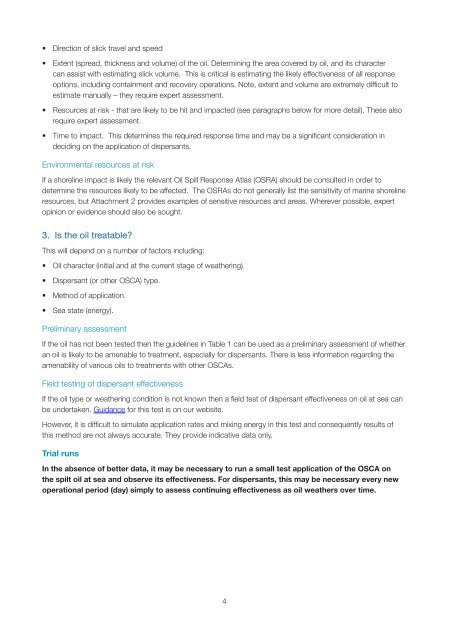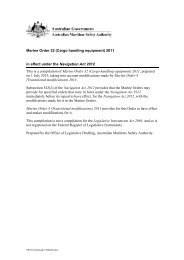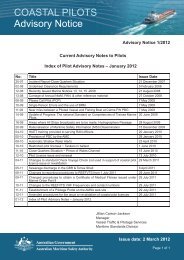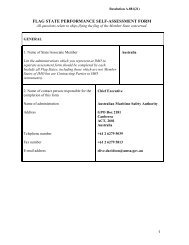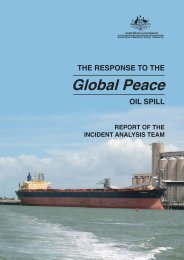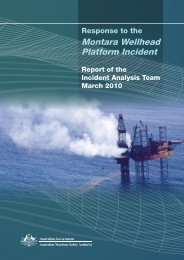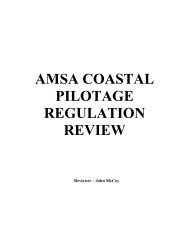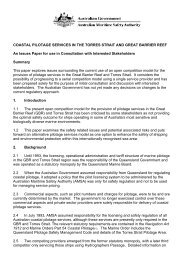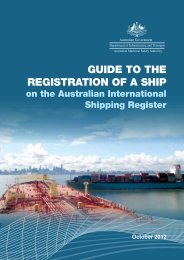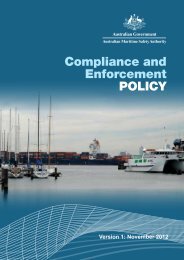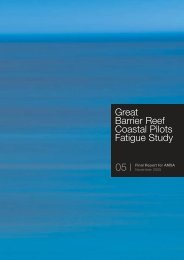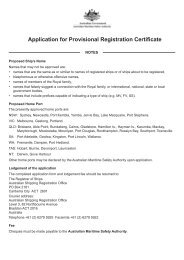Protocol for obtaining OSCA approval. - Australian Maritime Safety ...
Protocol for obtaining OSCA approval. - Australian Maritime Safety ...
Protocol for obtaining OSCA approval. - Australian Maritime Safety ...
You also want an ePaper? Increase the reach of your titles
YUMPU automatically turns print PDFs into web optimized ePapers that Google loves.
• Direction of slick travel and speed• Extent (spread, thickness and volume) of the oil. Determining the area covered by oil, and its charactercan assist with estimating slick volume. This is critical is estimating the likely effectiveness of all responseoptions, including containment and recovery operations. Note, extent and volume are extremely difficult toestimate manually – they require expert assessment.• Resources at risk - that are likely to be hit and impacted (see paragraphs below <strong>for</strong> more detail). These alsorequire expert assessment.• Time to impact. This determines the required response time and may be a significant consideration indeciding on the application of dispersants.Environmental resources at riskIf a shoreline impact is likely the relevant Oil Spill Response Atlas (OSRA) should be consulted in order todetermine the resources likely to be affected. The OSRAs do not generally list the sensitivity of marine shorelineresources, but Attachment 2 provides examples of sensitive resources and areas. Wherever possible, expertopinion or evidence should also be sought.3. Is the oil treatable?This will depend on a number of factors including:• Oil character (initial and at the current stage of weathering).• Dispersant (or other <strong>OSCA</strong>) type.• Method of application.• Sea state (energy).Preliminary assessmentIf the oil has not been tested then the guidelines in Table 1 can be used as a preliminary assessment of whetheran oil is likely to be amenable to treatment, especially <strong>for</strong> dispersants. There is less in<strong>for</strong>mation regarding theamenability of various oils to treatments with other <strong>OSCA</strong>s.Field testing of dispersant effectivenessIf the oil type or weathering condition is not known then a field test of dispersant effectiveness on oil at sea canbe undertaken. Guidance <strong>for</strong> this test is on our website.However, it is difficult to simulate application rates and mixing energy in this test and consequently results ofthis method are not always accurate. They provide indicative data only.Trial runsIn the absence of better data, it may be necessary to run a small test application of the <strong>OSCA</strong> onthe spilt oil at sea and observe its effectiveness. For dispersants, this may be necessary every newoperational period (day) simply to assess continuing effectiveness as oil weathers over time.4


